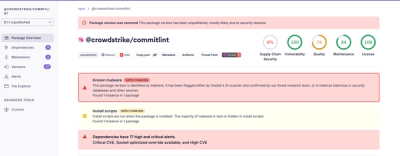
Research
Malicious fezbox npm Package Steals Browser Passwords from Cookies via Innovative QR Code Steganographic Technique
A malicious package uses a QR code as steganography in an innovative technique.
.. image:: https://img.shields.io/github/actions/workflow/status/nicoretti/prysk/ci.yaml :target: https://github.com/Nicoretti/prysk/actions
.. image:: https://img.shields.io/coverallsCoverage/github/Nicoretti/prysk :target: https://coveralls.io/github/Nicoretti/prysk
.. image:: https://img.shields.io/badge/imports-isort-ef8336.svg :target: https://pycqa.github.io/isort/
.. image:: https://img.shields.io/badge/code%20style-black-000000.svg :target: https://github.com/psf/black
.. image:: https://img.shields.io/pypi/v/prysk :target: https://pypi.org/project/prysk/
.. image:: https://img.shields.io/badge/docs-available-blue.svg :target: https://nicoretti.github.io/prysk/
Prysk is a fork of the popular snapshot testing tool Cram_. Even though Cram_ is pretty complete and mature for everyday use, Prysk wants to continue pushing its development forward.
.. _Cram: https://bitheap.org/cram
Prysk tests look like snippets of interactive shell sessions. Prysk runs each command and compares the command output in the test with the command's actual output.
Here's a snippet from Prysk's own test suite_:
.. code-block:: console
Set up prysk alias and example tests:
$ . "$TESTDIR"/setup.sh
Usage:
$ prysk -h
[Uu]sage: prysk \[OPTIONS\] TESTS\.\.\. (re)
[Oo]ptions: (re)
-h, --help show this help message and exit
-V, --version show version information and exit
-q, --quiet don't print diffs
-v, --verbose show filenames and test status
-i, --interactive interactively merge changed test output
-d, --debug write script output directly to the terminal
-y, --yes answer yes to all questions
-n, --no answer no to all questions
-E, --preserve-env don't reset common environment variables
--keep-tmpdir keep temporary directories
--shell=PATH shell to use for running tests (default: /bin/sh)
--shell-opts=OPTS arguments to invoke shell with
--indent=NUM number of spaces to use for indentation (default: 2)
--xunit-file=PATH path to write xUnit XML output
--dos2unix convert DOS/Windows line endings to UNIX line endings
--color mode which shall be used for coloring the output
The format in a nutshell:
Prysk tests use the .t file extension.
Lines beginning with two spaces, a dollar sign ($), and a space are run
in the shell.
Lines beginning with two spaces, a greater than sign (>), and a space
allow multi-line commands.
All other lines beginning with two spaces are considered command output.
Output lines ending with a space and the keyword (re) are
matched as Perl-compatible regular expressions_.
Lines ending with a space and the keyword (glob) are matched
with a glob-like syntax. The only special characters supported are
* and ?. Both characters can be escaped using \, and the
backslash can be escaped itself.
Output lines ending with either of the above keywords are always first matched literally with actual command output.
Lines ending with a space and the keyword (no-eol) will match
actual output that doesn't end in a newline.
Actual output lines containing unprintable characters are escaped
and suffixed with a space and the keyword (esc). Lines matching
unprintable output must also contain the keyword.
Anything else is a comment.
.. _Prysk's own test suite: https://github.com/Nicoretti/prysk/blob/master/test/integration/prysk/usage.t .. _Perl-compatible regular expressions: https://en.wikipedia.org/wiki/Perl_Compatible_Regular_Expressions
Prysk will print a dot for each passing test. If a test fails, a
unified context diff_ is printed showing the test's expected output
and the actual output. Skipped tests (empty tests and tests that exit
with return code 80) are marked with s instead of a dot.
For example, if we run Prysk on its own example tests_:
.. code-block:: diff
.s.!
--- examples/fail.t
+++ examples/fail.t.err
@@ -3,21 +3,22 @@
$ echo 1
1
$ echo 1
- 2
+ 1
$ echo 1
1
Invalid regex:
$ echo 1
- +++ (re)
+ 1
Offset regular expression:
$ printf 'foo\nbar\nbaz\n\n1\nA\n@\n'
foo
+ bar
baz
\d (re)
[A-Z] (re)
- #
+ @
s.
# Ran 6 tests, 2 skipped, 1 failed.
Prysk will also write the test with its actual output to
examples/fail.t.err, allowing you to use other diff tools. This
file is automatically removed the next time the test passes.
When you're first writing a test, you might just write the commands
and run the test to see what happens. If you run Prysk with -i or
--interactive, you'll be prompted to merge the actual output back
into the test. This makes it easy to quickly prototype new tests.
Is the same as invoking Prysk with --verbose and --indent=4.
Note that the following environment variables are reset before tests are run:
TMPDIR, TEMP, and TMP are set to the test runner's
tmp directory. In test output, occurrences of this directory are
replaced by $TMPDIR.
LANG, LC_ALL, and LANGUAGE are set to C.
TZ is set to GMT.
COLUMNS is set to 80. (Note: When using --shell=zsh,
this cannot be reset. It will reflect the actual terminal's width.)
CDPATH and GREP_OPTIONS are set to an empty string.
Prysk also provides the following environment variables to tests:
PRYSK_TEMP, set to the test runner's temporary directory.
TESTDIR, set to the directory containing the test file.
TESTFILE, set to the basename of the current test file.
TESTSHELL, set to the value specified by --shell.
Also note that care should be taken with commands that close the test
shell's stdin. For example, if you're trying to invoke ssh in
a test, try adding the -n option to prevent it from closing
stdin. Similarly, if you invoke a daemon process that inherits
stdout and fails to close it, it may cause Prysk to hang while
waiting for the test shell's stdout to be fully closed.
.. _unified context diff: https://en.wikipedia.org/wiki/Diff#Unified_format .. _its own example tests: https://github.com/nicoretti/prysk/tree/master/examples
FAQs
Functional tests for command line applications
We found that prysk demonstrated a healthy version release cadence and project activity because the last version was released less than a year ago. It has 1 open source maintainer collaborating on the project.
Did you know?

Socket for GitHub automatically highlights issues in each pull request and monitors the health of all your open source dependencies. Discover the contents of your packages and block harmful activity before you install or update your dependencies.

Research
A malicious package uses a QR code as steganography in an innovative technique.

Research
/Security News
Socket identified 80 fake candidates targeting engineering roles, including suspected North Korean operators, exposing the new reality of hiring as a security function.

Application Security
/Research
/Security News
Socket detected multiple compromised CrowdStrike npm packages, continuing the "Shai-Hulud" supply chain attack that has now impacted nearly 500 packages.